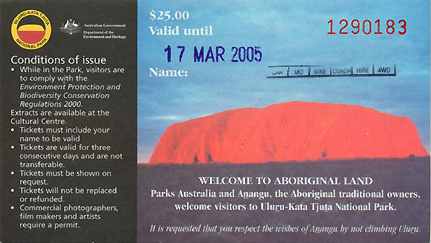 Today
was Uluru day. We woke up before dawn at about 5:15 so that we could
see the sunrise on Uluru. We were still a little sad this morning about
our camera, and having to use a cheap instamatic film camera really depressed
me but the day did get better. We really enjoyed the tour we had this morning.
We were picked up by a small tour bus from Anangu ("AN-anu") tours.
This group is linked closely with the Anangu aboriginies that are native to
this area. The word "Anangu" means "we people." The Anangu
people are actually a combination of two groups of Aboriginies that came together
to form "we people." They have been living under Uluru for
centuries and know all there is to know about it. The bus driver, not Anangu,
took us to his favorite spot to watch the pre-dawn colors behind Uluru.
We were the only ones there as all the other tourists had already gone to
the North East side of the rock to watch the sunrise. Chris, the driver, also
showed us the southern hemisphere's most well-known constellation: the Southern
Cross. It was the first time we've seen it and it brought to mind the Crosby
Stills and Nash song that says, "When you see the Southern Cross for
the first time, you'll understand now why you came this way." It was
a neat experience.
Today
was Uluru day. We woke up before dawn at about 5:15 so that we could
see the sunrise on Uluru. We were still a little sad this morning about
our camera, and having to use a cheap instamatic film camera really depressed
me but the day did get better. We really enjoyed the tour we had this morning.
We were picked up by a small tour bus from Anangu ("AN-anu") tours.
This group is linked closely with the Anangu aboriginies that are native to
this area. The word "Anangu" means "we people." The Anangu
people are actually a combination of two groups of Aboriginies that came together
to form "we people." They have been living under Uluru for
centuries and know all there is to know about it. The bus driver, not Anangu,
took us to his favorite spot to watch the pre-dawn colors behind Uluru.
We were the only ones there as all the other tourists had already gone to
the North East side of the rock to watch the sunrise. Chris, the driver, also
showed us the southern hemisphere's most well-known constellation: the Southern
Cross. It was the first time we've seen it and it brought to mind the Crosby
Stills and Nash song that says, "When you see the Southern Cross for
the first time, you'll understand now why you came this way." It was
a neat experience.
After our first sunrise moment, we joined everyone else to watch the sunrise
and change of colors on the rock itself. Again, our bus driver showed us the
perfect spot - a place where we could see not only Uluru but also Kata
Tjura (the Olgas), another large rock grouping about 30 kilometers from Uluru.
It literally was the only spot where you could see both and no one else was
there. Everyone else was around that area, but not in the best spot. So, we
watched a beautiful sunrise over Uluru and then went to the National
Park's Cultural Center where we had a lovely breakfast. The Center is also
focused on the Anangu.
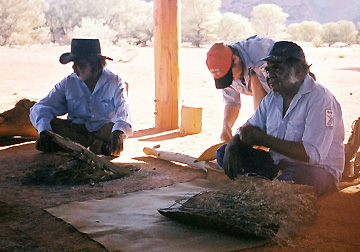 After
breakfast we started the best part of the morning, a tour led by an Aboriginal
guide named Richard. He conducted the tour in his native language and we had
an interpreter. Andy learned later that the interpreter actually manages Anangu
Tours and hopes that one day in the next few years the Aborigines can manage
and run it all themselves. Richard guided us through the desert below Uluru.
It was a hot day ("warm" to those who live here) and as usual for
this area, there were a lot of flies. These bugs were really irritating but
we got a little more used to them after a while. On our tour, we had two stops.
After
breakfast we started the best part of the morning, a tour led by an Aboriginal
guide named Richard. He conducted the tour in his native language and we had
an interpreter. Andy learned later that the interpreter actually manages Anangu
Tours and hopes that one day in the next few years the Aborigines can manage
and run it all themselves. Richard guided us through the desert below Uluru.
It was a hot day ("warm" to those who live here) and as usual for
this area, there were a lot of flies. These bugs were really irritating but
we got a little more used to them after a while. On our tour, we had two stops.
At the first, Richard
showed us some of his native tools and techniques for living off this land.
Many fruit trees grow at the base of Uluru and there are many animals
for food in the area, including goanna (large lizards) and kangaroos. Richard
actually showed us how to make glue from a plant with little white bumps.
He beat the plant to get these and the leaves off of it and then sifted them
in a wooden bowl ("women's work," he said) to separate the leaves
from the white powder. He then used a stick that was hot from the fire to
melt the white powder. After several times doing this, a black ball of glue
forms on the stick that can be melted like solder to patch holes in wooden
tools or glue spearheads to their shafts. He also showed us how he makes fire
(using kangaroo poo), explained some of his tools, and showed us what he uses
them for. I just loved learning all of this.
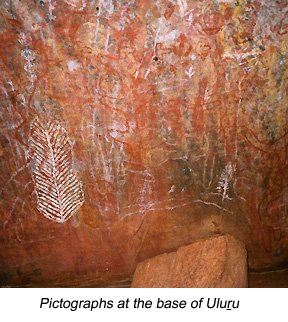 Richard
showed us a spear that was made from a thick vine. The vine starts out bent
and curly. But spear shafts need to be very straight, so Richand and his interpreter
build a fire (with kangaroo poo of course) and then put the vine in the fire
just long enough to make it pliable. The Anangu use their knees to straighten
the heated vine to make it as straight as possible. The spearhead is made
from a hard wood, sharpened and stuck to the shaft with their special glue.
They then secure the head further with the tendon of a kangaroo leg. After
another short walk, we stopped at a place with pictures drawn in the red dirt
with sticks. Richard used these pictures to tell a story about the
Blue-Tongued Lizard Man and the Crested Bellbird Man. It was all fascinating.
Richard
showed us a spear that was made from a thick vine. The vine starts out bent
and curly. But spear shafts need to be very straight, so Richand and his interpreter
build a fire (with kangaroo poo of course) and then put the vine in the fire
just long enough to make it pliable. The Anangu use their knees to straighten
the heated vine to make it as straight as possible. The spearhead is made
from a hard wood, sharpened and stuck to the shaft with their special glue.
They then secure the head further with the tendon of a kangaroo leg. After
another short walk, we stopped at a place with pictures drawn in the red dirt
with sticks. Richard used these pictures to tell a story about the
Blue-Tongued Lizard Man and the Crested Bellbird Man. It was all fascinating.
After our tour, we
went back to the hotel, took a lovely swim in the pool and had our first roll
of film developed in about five years. We were so happy when they actually
came out ok. They aren't as good as with our wonderful camera, but they will
do. We ended our Uluru part of the day with lunch at the hotel before
we got back on the road toward Alice Springs. The drive was much nicer. Clouds
came to cool off the afternoon so that we were more comfortable.
On the way, at a servo (gas station), Andy let Vienna try her hand at driving.
It was her first time actually behind the wheel and Andy's first time at instructing.
It was interesting to say the least. We all had fun as Vienna slowly made
her way around the servo parking lot. Except for a few stops and starts, she
seemed to do fine. I think she will do better with a professional instructor,
though.
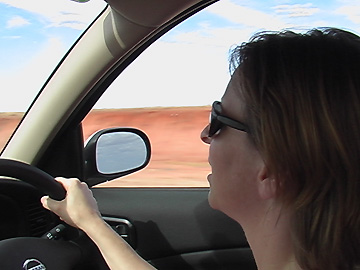 On
the last leg of the drive we headed for Alice Springs on Stuart Highway, which
in Northern Australia has no speed limit. Andy had gotten to drive this stretch
on the way to Uluru, and I got to drive it, today. Watch out world,
Jenny on the road with no speed limit! It was way cool and we cranked up Green
Day on the way, to Vienna's delight. We went as much as 170 km/hr (105 mph)
at times. Usually, I was between 140 and 160 (87-100 mph).
On
the last leg of the drive we headed for Alice Springs on Stuart Highway, which
in Northern Australia has no speed limit. Andy had gotten to drive this stretch
on the way to Uluru, and I got to drive it, today. Watch out world,
Jenny on the road with no speed limit! It was way cool and we cranked up Green
Day on the way, to Vienna's delight. We went as much as 170 km/hr (105 mph)
at times. Usually, I was between 140 and 160 (87-100 mph).
Back in Alice Springs, a hot and dusty old town, we found our motel. We stayed
at the White Gum motel, a very simple but clean motel near the downtown. We
had a great meal at Bojangles, a place known for its meat. I actually had
my first real Australian meat there. I had Territorial Soup which contained
buffalo, kangaroo and crocodile meat. I couldn't tell which was which but
it wasn't bad. The meal itself was great. Afterward, we walked a bit downtown.
Stores were closed but we were able to scope out a few places with reasonably
priced didgeridoos. We'll look more into getting one tomorrow before we fly
off to Cairns in the early afternoon.
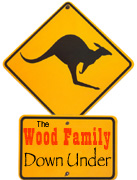
 Back
Back Forward
Forward